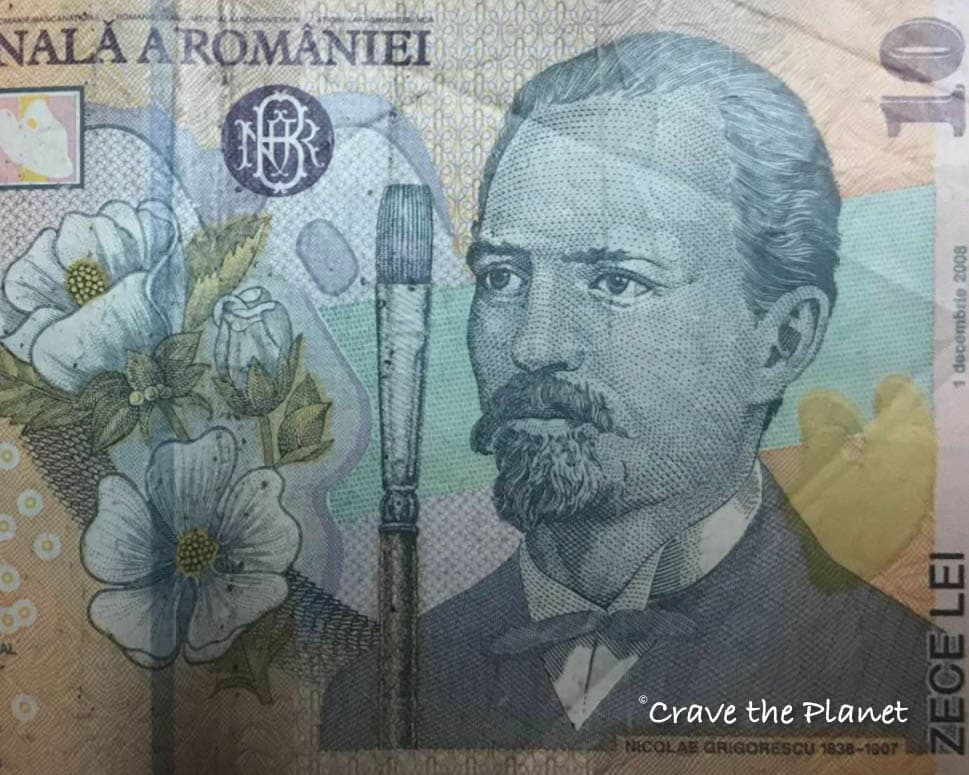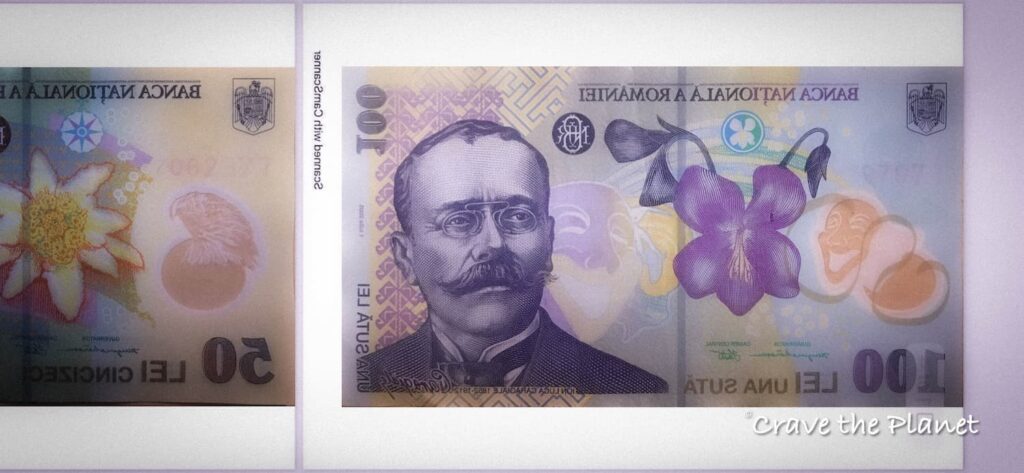Don’t be surprised like me when I visited Bucharest and noticed the currency in Romania wasn’t the Euro! (Despite being in the EU.)
In my search for a regenerative farm to invest, I was hoping to do math quickly when assessing real estate.
However, I was disappointed to learn that the euro is not the official currency, despite Romania being in the EU zone.
Strangely, its not in the Schengen area either! Even stranger, the currency in Montenegro is the euro and it’s not in the Schengen or EU.
Understanding Romanian Currency

Nevertheless, we found an amazing plot of grassland that the neighbors’ cows happily graze and help restore the topsoil. Now we go each year to hike along the breathtaking Via Transilvanica hiking trail.
Currency in Romania Pros and Cons
Widely accepted: The Romanian Leu is accepted throughout the country, making it easy to use for transactions.
Easy to obtain: You can easily obtain Romanian currency by withdrawing from ATMs or exchanging your currency at banks and exchange offices.
Lower exchange rate: The exchange rate for the Romanian Leu is generally lower than other currencies, making it a more affordable option for travelers.
No transaction fees: When using Romanian currency, you won't have to worry about transaction fees that may be charged when using credit or debit cards.
Limited use outside Romania: Once you leave Romania, the Romanian Leu may not be accepted in other countries. This means you may need to exchange it again, which can result in additional fees.
Counterfeit risk: There is a risk of counterfeit money in Romania, so it's important to be cautious when exchanging or using cash.
Difficulty exchanging back: If you have any leftover Romanian currency at the end of your trip, you may have difficulty exchanging it back to your home currency. It's best to plan your spending accordingly.
Quick Facts

Leu (Lei-plural)and Ban
When traveling to Romania, it’s important to understand the country’s national currency, the Romanian Leu (RON). The leu is divided into 100 bani, which are the sub-units of the currency. The word “leu” means “lion” in English, and the name of the currency is derived from the Dutch word “leeuwendaalder,” which was a coin that was used in the 17th century.
Coins and Banknotes
Romanian currency is available in both coins and banknotes. The coins are available in denominations of 1, 5, 10, and 50 bani, while the banknotes are available in denominations of 1, 5, 10, 50, 100, 200, and 500 lei. However, the 200 and 500 lei banknotes are seldom used in daily transactions.
Denominations and Valuation
The value of the Romanian leu can fluctuate against other currencies, so it’s important to keep an eye on the exchange rate if you plan to exchange money. As of August 8, 2023, 1 euro is equal to approximately 4.5 RON.
Here is a table of the current denominations and their approximate values:
| Denomination | Approximate Value |
|---|---|
| 1 ban | 0.00022 euro |
| 5 bani | 0.0011 euro |
| 10 bani | 0.0022 euro |
| 50 bani | 0.011 euro |
| 1 leu | 0.22 euro |
| 5 lei | 1.11 euro |
| 10 lei | 2.22 euro |
| 50 lei | 11.11 euro |
| 100 lei | 22.22 euro |
| 200 lei | 44.44 euro |
| 500 lei | 111.11 euro |
When exchanging money, it’s important to note that some exchange offices may charge a commission fee. It’s best to compare rates and fees before making a transaction.
🔃 Looking for a currency transfer service?
If you need change dollars for euros for your trip, then my personal recommendation is to choose Wise, an Award winning and safe money transfer website. You can find and compare currency rates globally there.
Transfer Money HEREHistory of Romanian Currency

Introduction of Leu
The Romanian currency, known as the leu, was first introduced in 1867. At that time, the leu was a bimetallic currency that was equal to 5 grams of 83.5% silver or 0.29032 grams of gold. The first leu coin was minted in Romania in 1870, and before 1878, the silver Russian ruble was valued so highly that it drove the native coins out of circulation.
Transition to New Leu
In 2005, the Romanian government replaced the old leu with the new leu (RON). The base denomination of the new leu is 1 leu (plural lei), and the “N” in RON stands for “New Leu.” The transition was made to simplify the currency system and to bring it in line with other European countries. The new leu is now the official currency of Romania.
Role of National Bank
The National Bank of Romania (BNR) plays a crucial role in the country’s monetary system. The BNR is the central bank of Romania and is responsible for issuing and regulating the country’s currency. The BNR also manages the country’s foreign exchange reserves and sets interest rates to control inflation.
Monetăria Statului is the agency responsible for minting the coins and banknotes in Romania. The agency is under the authority of the Ministry of Public Finance and operates under the supervision of the National Bank of Romania.
Currency Exchange in Romania
Understanding Exchange Rates
Before exchanging currency in Romania, it’s important to understand exchange rates. The exchange rate is the value of one currency in relation to another. In Romania, the currency used is the Romanian leu (RON). When exchanging currency, you will need to know the current exchange rate between your currency and RON. You can use a currency converter like XE to get an idea of the current exchange rate.
Where to Exchange Currency
There are several places where you can exchange currency in Romania. You can exchange currency at banks, exchange offices, and even some hotels. Banks typically offer the best exchange rates, but they may charge higher fees and commissions. Exchange offices may offer lower exchange rates, but they may charge lower fees and commissions. It’s important to shop around to find the best exchange rates and fees.
Commission and Fees
When exchanging currency in Romania, you may be charged commission and fees. Banks and exchange offices may charge different fees and commissions, so it’s important to compare rates.
Some banks may charge a flat fee, while others may charge a percentage of the total amount exchanged. Exchange offices may charge a commission based on the amount exchanged.
Some exchange offices may offer lower exchange rates but charge higher fees and commissions. It’s important to factor in all fees and commissions when deciding where to exchange currency.
Using ATMs in Romania
If you need cash in Romania, ATMs are the most convenient way to get it. Here are some important things to know about using ATMs in Romania.
ATM Locations
ATMs in Romania are widely available and can be found in most cities and towns. You can find them at banks, shopping centers, airports, and other public places.
To locate the nearest ATM, you can use the ATM locator of your bank or credit card company. Some of the popular ATM locators in Romania are:
- BCR ATM locator
- Alpha Bank ATM locator
- Raiffeisen ATM locator
- Unicredit ATM locator
- BRD ATM locator
Withdrawal Limits
The withdrawal limit for ATMs in Romania varies depending on the bank and the type of account you have. Generally, the limit is around 1,000-2,000 RON (Romanian Leu) per day. However, some banks may have lower or higher limits. If you need to withdraw a large amount of cash, you may need to make multiple withdrawals or contact your bank in advance to increase your withdrawal limit.
Transaction Fees
When using an ATM in Romania, you may be charged a transaction fee by your bank or credit card company. Additionally, some local ATMs may charge a fee for using their services. To avoid paying excessive fees, it is recommended to use ATMs that are connected to local bank branches. NEVER use Euronet ATMs as they charge a fee as well as offer poor exchange rates. Most bank-owned ATMs also charge lower fees than other ATMs.
It is important to remember to choose to be charged in the local currency without conversion. Some ATMs may offer to convert your foreign currency to the local currency, but this may result in a poor exchange rate and additional fees.
Cards and Digital Payments
If you are planning to travel to Romania, it is important to know how to use cards and digital payment options. In this section, we will cover the basics of using cards and digital payments in Romania.
However, many smaller villages like the ones we hiked on only accepted cash payment or bank transfers.

Using Cards in Romania
Most merchants in Romania accept credit and debit cards, and you can use them to pay for goods and services at supermarkets, restaurants, and shops. Visa and Mastercard are widely accepted, but American Express and Discover may not be accepted at all merchants.
It is important to note that some merchants may require a minimum purchase amount to use a card, so it is a good idea to carry some cash with you. Additionally, some merchants may charge an extra fee for using a card, so it is important to check before making a purchase.
Digital Payment Options
Digital payment options are becoming increasingly popular in Romania, and there are several options available. One popular option is BT Pay, which is a mobile payment app offered by Banca Transilvania. The app allows you to make payments using your smartphone, and you can link it to your credit or debit card.
Another popular option is Apple Pay, which is accepted at many merchants in Romania. You can link your credit or debit card to Apple Pay and make payments using your iPhone or Apple Watch. Other digital payment options include Fitbit Pay and Garmin Pay.
Transaction Fees
When using cards or digital payment options in Romania, you may be subject to foreign transaction fees. These fees are charged by your bank and can vary depending on the type of card you have. It is important to check with your bank before traveling to Romania to see what fees may apply.
In addition to foreign transaction fees, some merchants may charge an extra fee for using a card. This is known as a surcharge, and it is important to check before making a purchase.
Economic Context of Romanian Currency
Romania and the Eurozone
As of August 2023, Romania is not a member of the Eurozone, which is a monetary union of 19 European Union (EU) member states that have adopted the euro as their sole currency.
However, Romania is scheduled to adopt the euro as its primary currency in 2024, subject to meeting the necessary convergence criteria set by the European Commission.
Inflation and Interest Rates
Inflation is an important factor affecting the value of the Romanian currency. The National Bank of Romania (NBR) aims to keep inflation within a target range of 1.5% to 3.5%. The inflation rate in Romania has been below this target range in recent years, with a rate of 1.3% in 2022.
Interest rates also play a crucial role in the value of the Romanian currency. The NBR sets the monetary policy rate, which is the interest rate at which commercial banks can borrow from the central bank. The current monetary policy rate in Romania is 1.5%.
Economic Stability
Maintaining economic stability is a key priority for the Romanian government. The country has experienced significant economic growth in recent years, with a GDP growth rate of 6.1% in 2021. However, the COVID-19 pandemic and the war in Ukraine have exposed structural vulnerabilities in the economy.
The budget deficit has been a concern in recent years, averaging above 4% due to pension increases and other factors. Mugur Isărescu, the Governor of the National Bank of Romania, has emphasized the need for fiscal discipline to maintain economic stability.
Comparing Romanian Leu with Other Currencies
Leu and USD
As of today, 1 Romanian Leu (RON) is equivalent to 0.23 US Dollars (USD). This means that if you have 100 RON, you can exchange it for 23 USD. The exchange rate between RON and USD can fluctuate over time due to various economic, political, and market factors. It is advisable to check the current exchange rate before making any currency exchange transactions.
Leu and Euro
Romania is a member of the European Union, but the country still uses its local currency, the Leu, instead of the Euro. As of today, 1 RON is equivalent to 0.21 Euros (EUR). This means that if you have 100 RON, you can exchange it for 21 EUR. The exchange rate between RON and EUR can also fluctuate over time due to various economic, political, and market factors.
Leu and Other Regional Currencies
The Bulgarian Lev (BGN) is another currency used in the region. As of today, 1 RON is equivalent to 0.44 Bulgarian Levs (BGN). The Swiss Franc (CHF) is another currency that is widely used in Europe. As of today, 1 RON is equivalent to 0.21 Swiss Francs (CHF).
The Moldovan Leu (MDL) and Turkish Lira (TRY) are also currencies used in neighboring countries. As of today, 1 RON is equivalent to 1.36 Moldovan Leu (MDL) and 1.92 Turkish Lira (TRY).
It is important to note that exchange rates can fluctuate over time due to various economic, political, and market factors. It is advisable to check the current exchange rate before making any currency exchange transactions.
Practical Information for Travelers
When traveling to Romania, it’s important to be prepared with practical information to ensure a smooth and enjoyable trip. Here are some things to keep in mind:
Spending Money in Romania
The official currency in Romania is the Romanian leu (RON). While credit cards are accepted in many places, it’s always a good idea to have some cash on hand for smaller purchases and in case of emergencies. ATMs are widely available throughout the country, including at the airport and in major cities like Bucharest. When withdrawing money, be sure to choose the option to be charged in the local currency to avoid additional fees.
When shopping, keep in mind that haggling is not common practice in Romania. Prices are usually fixed, so there’s no need to negotiate. Many shops and restaurants will also accept euros, but be aware that the exchange rate may not be favorable.
Travel Insurance
It’s always a good idea to have travel insurance when visiting Romania, especially during the COVID-19 pandemic. Many travel insurance policies now offer coverage for COVID-related issues, such as medical expenses and trip cancellations. Be sure to check the policy details carefully to ensure that you have adequate coverage for your needs.
Planning your trip?
- 🏨 Book your perfect stay on Booking.com
- 🎢 Make your trip more exciting with GetYourGuide
- 🚗 Hire a car with Discover Cars
- ✈️ Find cheap flight tickets with WayAway
- 📲 Buy eSIMs with Airalo
- 🥾 Get off the beaten tourist path with Fully Planned and Booked Unguided Hut to Hut Hiking Trip
Car Rental
If you plan on renting a car in Romania, be sure to book in advance and read the rental agreement carefully. Some rental companies may require an international driver’s license, while others may have restrictions on where you can take the car. Discovercars is a popular car rental company in Romania, offering a wide range of vehicles at competitive prices.
Public Transportation
Public transportation is widely available in Romania, including buses, trams, and trains. In Bucharest, the metro is a convenient and affordable way to get around the city. Tickets can be purchased at kiosks or from the driver/conductor. Taxis are also readily available, but be sure to use only licensed taxis and negotiate the fare before getting in.
Tours and Attractions
There are many tours and attractions to choose from in Romania, including historical landmarks, scenic drives, and outdoor activities. GetYourGuide is a popular platform for booking tours and activities, offering a wide range of options at competitive prices. When visiting attractions, be sure to follow any posted rules and regulations, and respect the local culture and customs.
🔃 Looking for a currency transfer service?
If you need change dollars for euros for your trip, then my personal recommendation is to choose Wise, an Award winning and safe money transfer website. You can find and compare currency rates globally there.
Transfer Money HEREFrequently Asked Questions
What is the currency of Romania?
The official currency of Romania is the Romanian Leu (RON). It is divided into 100 bani. The Romanian Leu has been the currency of Romania since 1867, and it is the only legal tender in the country.
How does the Romanian currency compare to the Nigerian Naira?
The exchange rate between the Romanian Leu and the Nigerian Naira varies depending on the current market rates. As of the current date, 1 Romanian Leu is equivalent to approximately 94 Nigerian Naira. It is important to note that exchange rates can fluctuate frequently, so it is always a good idea to check the current rates before making any currency exchanges.
What is the exchange rate from Romanian currency to British Pound?
The exchange rate between the Romanian Leu and the British Pound also varies depending on the current market rates. As of the current date, 1 Romanian Leu is equivalent to approximately 0.18 British Pound. Again, it is important to note that exchange rates can fluctuate frequently, so it is always a good idea to check the current rates before making any currency exchanges.
Is the Romanian currency accepted in Nepal?
No, the Romanian Leu is not accepted in Nepal. The official currency of Nepal is the Nepalese Rupee (NPR). If you are planning to travel to Nepal, it is recommended that you exchange your Romanian Leu for Nepalese Rupees before your trip.
What is the symbol for the Romanian currency?
The symbol for the Romanian Leu is “lei”. It is represented by the symbol “L” or “RON”. The symbol “L” is used more commonly in Romania, while “RON” is used more frequently in international transactions.
Can I use Euros in Romania?
While some businesses in Romania may accept Euros, the official currency of Romania is the Romanian Leu. It is recommended that you exchange your Euros for Romanian Leu before your trip to ensure that you have the correct currency for your transactions.
We hope this guide to the currency in Romania is filled with interesting information and has given you the proper information to plan your visit to this hidden gem in Europe!
More Romania Travel Blogs
- Best Things to do in Transylvania
- Via Transilvanica Hike Ultimate Guide
- Via Transilvanica Hike Quick Guide
- Via Transilvanica Trail Marker Guide
- Is Cluj Worth Visiting?
- Is Brasov Worth Visiting?
- How to Drink Palinka
- Currency in Romania

Author profile: Morgan Fielder is a Doctor of Physical Therapy and passionate hiker who believes in exploring the world on foot with good food. Follow her journey as she shares science-based hiking tips and advocates for sustainable tourism.
